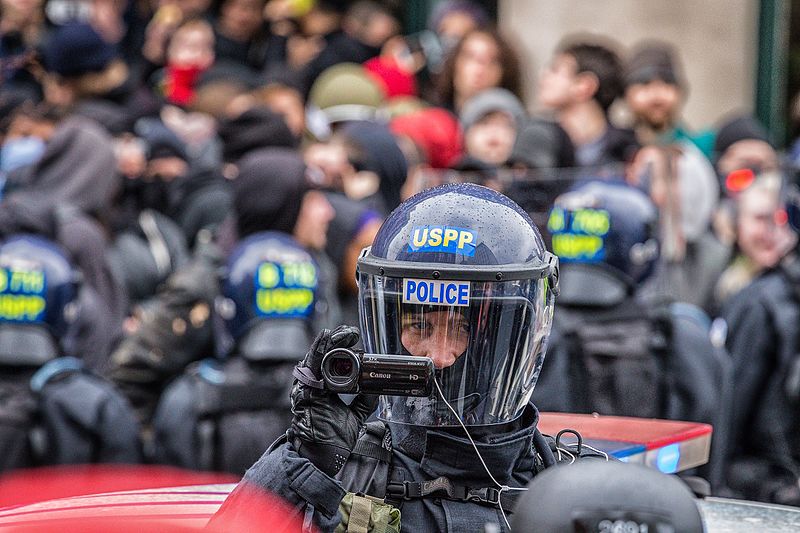Four Obstacles to Local Surveillance Ordinances
Our research reveals common traits that thwarted municipal efforts to establish local civilian control over law enforcement surveillance.

Published by The Lawfare Institute
in Cooperation With

In a previous piece, one of us (Fidler) analyzed ordinances in 14 localities that govern how local police can surveil residents. Her related paper in the Santa Clara High Technology Law Journal concludes that these laws have so far been reasonably successful. Media and advocacy reports indicated that a set of other cities—St. Louis, Missouri; Northampton, Massachusetts; Ann Arbor, Michigan; Hartford, Connecticut; and Miami Beach, Florida—are in the process of developing similar laws. But progress on such laws in most of these cities has been stalled for years. Why have these efforts failed when efforts in other cities succeeded?
Our research reveals four common traits that seemed to thwart initial efforts to establish local civilian control over law enforcement surveillance in these cities. Substantial objections from “strong” mayors and close ties between the police and lawmakers are the first two. In addition, ordinances tended to struggle when narratives about the ordinance became overly centered on surveillance cameras or dominated by messaging about government overreach or threats to public safety. Although we remain optimistic about local control over surveillance, identifying these traits helps shed light on the drawbacks of a city council-led approach. We also hope that identifying these traits can help policy advocates assess the local landscape before launching campaigns and better prepare to meet these obstacles.
Objections From “Strong” Mayors
Three of the five cities with stalled proposals had strong mayors who objected to the ordinances. Cities in the U.S. are sometimes described as having either “strong” or “weak” mayors. These terms indicate the relative power of the executive compared to the legislative branch within municipal government. For our purposes, we define strong mayors as those who possess veto powers and absolute appointment powers for administrative heads, and semi-strong mayors as those who possess only veto power. St. Louis, Hartford and Northampton all have strong or semi-strong mayors who objected to the proposed ordinances. The mayor’s office in St. Louis blindsided the legislative sponsors of the city’s surveillance bill with its own proposed executive order in 2019, accompanied by a statement that the “accountability of how the city uses surveillance technology needs to rest firmly on the Mayor.” The mayor’s office also slow-walked its cooperation with the council’s requests for information that would inform the drafting process, delaying developments on the bill by at least 6 months. In Hartford, the mayor did not weigh in on the ordinance directly but actively supported increasing police surveillance technology at the time the ordinance was under consideration.
Northampton’s mayor in 2017 also vetoed its surveillance ordinance. This veto was unusual, though: The mayor issued a veto on the grounds that the ordinance was not comprehensive enough. Council members indicated that they were surprised by the mayor’s late-in-the game objection. Perhaps the mayor’s desire was sincere, or perhaps it was a convenient rationale for a veto, but the end result was the same: No ordinance passed. Overall, objections from a strong mayor do not automatically doom a local surveillance ordinance, but they do make passage more difficult.
Strong Police Lobbying Power
Strong police lobbying power seems particularly effective in stopping an ordinance’s progress early on. In four cities we examined—Ann Arbor, Hartford, St. Louis and Miami Beach—the proposed ordinances never reached the mayor’s desk, and, in each, the police were vocal in their opposition from the start. Ann Arbor’s police chief did not voice his “complete and unequivocal support,” without which council members hesitated to move forward. Hartford’s police chief expressed concerns about the proposed ordinance, and the city council continued to approve funding increases for surveillance programs. In St. Louis, council members refused to move forward without buy-in from the police chief after four years of public debate; the chair of the public safety committee, which has jurisdiction over the ordinance, has stated in public meetings that “I really like the police” and has two children in the department. In Miami Beach, the police submitted a memorandum opposing the ordinance on July 26, 2017, and the ordinance never again showed up on the council’s agenda. This post is not a complete analysis of correlations between police support and passage—we do not analyze police support patterns in the 14 cities that have succeeded in passing such laws—but the frequency of police objection, or lawmaker insistence on police support, in cities with ordinances that fizzled is worth noting for advocates. Indeed, police objection may be sufficient for the failure of an ordinance: Miami Beach had only two out of four “problem” factors present, the fewest of the five cities, but police objection was among them.
A Focus on Surveillance Cameras
In four of the five cities with stalled proposals, narratives about the ordinances, or the ordinances themselves, became dominated by one technology—surveillance cameras. Residents and lawmakers alike seemed to favor the use of cameras, even if they might support restrictions on other forms of surveillance. A dozen Hartford residents attended a 2018 public hearing on the ordinance, opposing the proposal and “voicing their support for more police cameras on the street.” In St. Louis, one alderwoman based her opposition to the ordinance on the (incorrect) perception that the ordinance would prohibit surveillance cameras. Ann Arbor’s ordinance sought to regulate only surveillance cameras. The city’s police chief supported civilian oversight of surveillance generally but opposed restrictions on cameras specifically. Similarly, Northampton’s proposed ordinance applied only to cameras.
In contrast to the stalled proposals, none of the successful ordinances focused on surveillance cameras specifically, nor did narratives surrounding their passage become dominated by debates about surveillance cameras. Advocates would be wise to steer drafters and public conversations away from a focus on this issue.
Narrative Traps—Government Overreach and Endangering Public Safety
In all five of the cities we surveyed, the narratives surrounding the ordinances fell prey to the American bogeyman of government overreach and endangering public safety. Opposition testimonies painted the ordinances as both topical and fiscal government overreach. In every city, debates prominently featured some version of a statement by the mayor of Lawrence, Massachusetts, one of the 14 successful cities: “[T]he council is creating solutions to a problem that does not exist.” In a few cities, St. Louis and Northampton, the mayor’s office accused the council of essentially duplicating laws that were already in place. Criticisms that the ordinances would be irresponsibly expensive also dominated debates. St. Louis’s mayor’s office and the Miami Beach police both cited high projected costs (“thousands of man hours”) as grounds for opposing the ordinances. Hartford’s police chief, Hartford members of the public, Ann Arbor council members and Ann Arbor police all expressed versions of the fear that the ordinances would hinder the police’s ability to fight crime. Cost, government overreach and fear of increased crime are all well-worn tactics to oppose new legislation in the U.S., and local surveillance ordinances prove no exception.
Conclusion
Even the presence of multiple factors identified above does not mean an ordinance is doomed to fail: Lawrence, Massachusetts, overrode a mayoral veto to pass a surveillance ordinance in 2018. Lawrence’s council also overturned a subsequent mayoral veto of surveillance camera regulations made pursuant to the ordinance in 2019, avoiding both the camera trap and criticisms of overreach. Still, advocates should watch for signs of these factors in the cities in which they work. Cities with strong mayors and strong police lobbies should be approached with care, extra resources and an emphasis on relationship-building. Drafters should be encouraged to craft comprehensive, rather than camera-specific ordinances, and the public should likewise be educated about the contents of the proposals. Continuing to establish narratives about the harms of police surveillance would also be wise—harnessing the relatively positive public opinion about the continuing 2020 protests against police could be helpful in accomplishing this aim.




.jpg?sfvrsn=676ddf0d_7)

